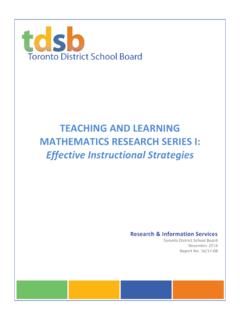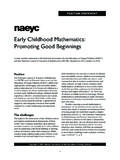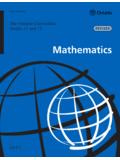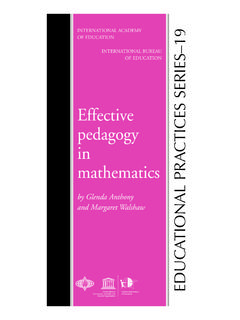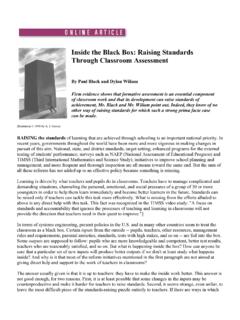Transcription of Challenges and opportunities in teaching mathematics
1 teaching mathematics Challenges and opportunities in teaching mathematics Merrilyn Goos University of Queensland >. At the special conference celebrating the 50th anniversary of the Australian Association of mathematics Teachers (AAMT), I was asked to speak about Challenges and opportunities in teaching mathematics as a stimulus for discussion of AAMT's future directions . With an open LQYLWDWLRQ WR EH D OLWWOH SURYRFDWLYH , FKRVH WKH YH FKDOOHQJHV GHSLFWHG LQ )LJXUH , KDYH IUDPHG . these Challenges as questions to draw you into a conversation with your colleagues and, vicari- ously, with me. I end my brief discussion of each challenge with another kind of question that I hope will point us towards opportunities and directions for the next 50 years. :KR LV TXDOL HG . to teach mathe- matics to children and young people? How do we shape Is mathematics public perceptions teaching an of mathematics ?
2 Attractive and viable career? What counts Who gets to learn as effective mathematics ? mathematics teaching ? Figure 1. Five Challenges for teaching mathematics in Australia. :KR LV TXDOL HG WR WHDFK PDWKHPDWLFV WR FKLOGUHQ . and young people? :KDW GRHV LW PHDQ WR EH TXDOL HG WR WHDFK PDWKHPDWLFV" 7 KLV LV DQ LPSRUWDQW TXHVWLRQ EHFDXVH . any profession is distinguished in part by a body of specialised knowledge, practices, and ethical orientations that new entrants to that profession are expected to acquire. More than ten years DJR $$07 GHYHORSHG D VHW RI SURIHVVLRQDO VWDQGDUGV WKDW LGHQWL HG WKH NQRZOHGJH DWWULEXWHV DQG . practices required for excellent teaching of mathematics . For example, excellent teachers have a thorough knowledge of the students they teach , a sound, coherent knowledge of the mathemat- ics appropriate to the student level they teach , and rich knowledge of how students learn mathe- matics (AAMT, 2006).
3 This AAMT initiative showed tremendous foresight in making a case for SURIHVVLRQDO WHDFKLQJ VWDQGDUGV VSHFL F WR WKH GLVFLSOLQH RI PDWKHPDWLFV . 34 amt 72(4) 2016. Now we have the more generic Australian Professional Standards for Teachers (AITSL, 2014), with the three domains of professional knowledge, professional engagement, and professional practice structured similarly to those proposed by the AAMT Standards. For example, in the Professional Knowledge domain, teachers are required to know students and how they learn, and know the content and how to teach it. University programs for initial teacher education are accredited, in part, on the basis of ensuring that our graduates satisfy these requirements. However, initial teacher education in Australia is undergoing substantial reforms (see http: ). One of the new requirements is that all graduates of primary initial teacher education programs will not only be prepared to teach across the primary curriculum, but also have advanced knowledge and skills in one subject area.
4 Priority for subject specialisation will be given to mathematics , science, and languages. We might wonder whether it makes sense to say that a new graduate, however well prepared to teach primary school mathematics , could be regarded as having advanced skills and knowledge in mathematics and mathematics teaching . What should be the role of a mathematics subject specialist in the primary school? How should new graduates take up such a role? $QRWKHU DVSHFW RI GHFLGLQJ ZKR LV TXDOL HG WR WHDFK PDWKHPDWLFV LV WR FRQVLGHU WKH ORQJ . VWDQGLQJ XQGHU VXSSO\ RI VHFRQGDU\ VFKRRO PDWKHPDWLFV WHDFKHUV ZLWK IRUPDO TXDOL FDWLRQV IRU . this role. By this I mean teachers who have taken university courses in both mathematics and mathematics teaching methods to the extent required by program accreditation standards. (The current requirements can be found in AITSL, 2015).
5 Depending on the source of data, it seems likely that at least 20% of lower secondary school mathematics classes are taught by teachers ZLWKRXW IRUPDO TXDOL FDWLRQV DV PDWKHPDWLFV WHDFKHUV ]LH HW DO . This is not a new problem. And I can't see the situation changing in a country like Australia that is geographically large but with a small, dispersed population. So even if we achieve some success in recruiting more people into secondary mathematics teaching I think it's unlikely that HYHU\ VHFRQGDU\ VFKRRO LQ WKH FRXQWU\ ZLOO EH IXOO\ VWDIIHG ZLWK TXDOL HG PDWKHPDWLFV WHDFKHUV . 7 KLV OHDGV PH WR ZRQGHU DERXW WKH SURIHVVLRQDO LGHQWLW\ DQG VWDWXV RI RXW RI HOG WHDFKHUV . of mathematics , and the extent to which we welcome them as valued colleagues within our professional community. Are they one of us ? +RZ DUH RXW RI HOG PDWKHPDWLFV WHDFKHUV SRVLWLRQHG LQ our profession?
6 What kind of professional support is being offered, RU VKRXOG EH RIIHUHG WR HQDEOH RXW RI HOG WHDFKHUV WR GHYHORS . professional knowledge for mathematics teaching ? Is mathematics teaching an attractive and viable career? Now let's zoom in on those who have decided to become secondary mathematics teachers. How good are we at supporting and retaining them within our profession? , KDYH IRXQG QR GDWD VSHFL F WR PDWKHPDWLFV WHDFKLQJ EXW LQVWHDG , GUDZ RQ D VWXG\ . conducted by the Queensland College of Teachers (2013) on attrition of recent graduate teach- HUV 7KH VWXG\ LGHQWL HG DQG VXUYH\HG WHDFKHUV ZKR KDG EHHQ UHPRYHG IURP WKH UHJLVWHU ZLWKLQ . four years of graduation in the years from 2006 to 2008 ( of this cohort), and conducted interviews with a sample of the survey respondents. The report of the Queensland College of Teachers (QCT) study indicates that attrition exacerbates shortages in some specialist areas and some geographical locations, and that secondary teachers of science, special education and mathematics are most likely to leave WHDFKLQJ 4&7 S )URP WKH ULFK LQIRUPDWLRQ SURYLGHG E\ WKLV UHSRUW WZR QGLQJV.
7 Stood out for me: amt 72(4) 2016 35. 2QO\ RI 4 XHHQVODQG WHDFKHUV JUDGXDWLQJ LQ WKH SHULRG IURP ZHUH . appointed to permanent positions. 7 KHUH ZHUH OLPLWHG VXSSRUW DFWLYLWLHV IRU EHJLQQLQJ WHDFKHUV WKH DFWLYLW\ WKDW UHVSRQGHQWV . found most valuable was observing other teachers' lessons ( agreement); yet this was also the least common (only 50% of respondents had done so). Perhaps we can do little about the systemic problems with workforce planning that lead to uncertainty of tenure for beginning teachers. But let me tell you about the options listed in the survey for supporting new graduates induction programs, professional development work- shops, being observed and receiving feedback none of these was perceived to be as valuable as having the opportunity to observe a more experienced teacher in the mathematics classroom . Will you offer this opportunity to a beginning teacher in your school?
8 How should beginning teachers of mathematics be supported WR VWD\ DQG RXULVK LQ RXU SURIHVVLRQ". What counts as effective mathematics teaching ? As professional educators we are under increasing pressure to justify our practices in terms of improving students' learning outcomes. This is why a research team of which I am a member ZDV UHFHQWO\ FRPPLVVLRQHG E\ WKH 2I FH RI WKH $XVWUDOLDQ &KLHI 6 FLHQWLVW WR EHJLQ GHYHORSLQJ . an evidence base for best practice in mathematics education. Our task was to identify schools showing high gains in NAPLAN Numeracy from Years 3 5 and Years 7 9 during 2011 2013 and 2012 2014 and to examine their practices in mathematics education. For jurisdictions where no gain scores were available for Years 7 9 that is, those for which Year 7 was in primary school while Year 9 was in secondary school we instead selected schools with superior NAPLAN perfor- mance in Year 9.
9 There are many methodological Challenges in a project like this: for example, we cannot be sure that the students in any school who sat for the Year 5 NAPLAN tests are the same students who, two years earlier, sat for the Year 3 NAPLAN tests at the same school. And we also know WKDW 1$3/$1 SHUIRUPDQFH MXVW OLNH DQ\ RWKHU W\SH RI DFDGHPLF SHUIRUPDQFH FDQ EH LQ XHQFHG . by a range of factors within and beyond the school. We designed our data collection to investigate WKLV FRPSOH[ ZHE RI LQ XHQFH XVLQJ VXUYH\V RI VFKRRO OHDGHUV WHDFKHUV DQG VWXGHQWV LQ VFKRROV . throughout Australia, together with case studies in 52 schools that met the NAPLAN success . criteria outlined above. We found that while there was no single approach to teaching mathematics amongst the successful schools, these schools did share some common characteristics. In particular, schools that had achieved high NAPLAN gains or high NAPLAN performance demonstrated a clear and purposeful focus on mathematics /numeracy and strong curriculum leadership with a collegial approach to professional learning.]
10 In these schools, teachers were enthusiastic about teaching mathematics and were committed to developing students' mathematical understanding. From this project, we discovered that mathematics leadership was crucial to students' learning. How can schools be supported to develop mathematical leadership capacity? Who gets to learn mathematics 7 KHUH DUH PDQ\ ZD\V RI LQWHUSUHWLQJ WKLV TXHVWLRQ /HW V ORRN UVW DW ZKR VXFFHHGV LQ OHDUQLQJ . mathematics , based on 2012 PISA data. 36 amt 72(4) 2016. ,Q 3,6$ $XVWUDOLDQ VWXGHQWV PDWKHPDWLFDO OLWHUDF\ SHUIRUPDQFH ZDV VLJQL FDQWO\ . above the OECD average (Thomson, De Bortoli, & Buckley, 2013). However, there were VWDWLVWLFDOO\ VLJQL FDQW GLIIHUHQFHV EHWZHHQ WKH PHDQ DFKLHYHPHQW VFRUHV RI $XVWUDOLDQ . students in different groups. Figure 2. Mathematical literacy performance differences in PISA 2012 for Australian students.










